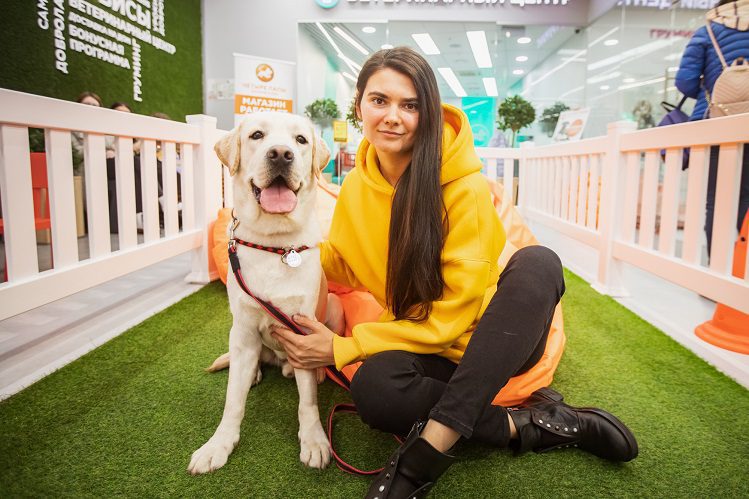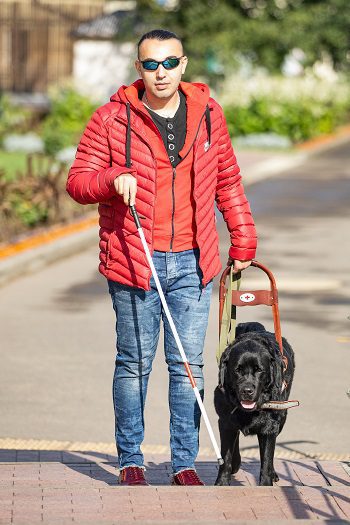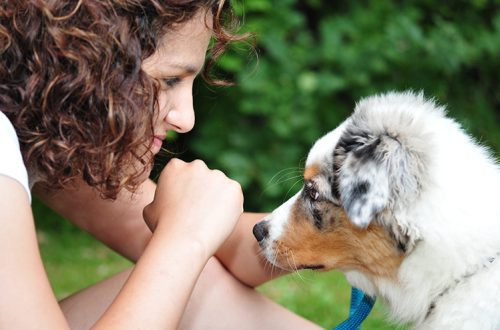
How guide dogs are trained and how each of us can help
Where and how guide dogs are trained, Elina Pochueva, fundraiser of the center, tells.
– Please tell us about yourself and your work.
– My name is Elina, I am 32 years old, I am a fundraiser of the dog training center “”. My task is to raise funds to ensure the work of our organization. I have been in the team of our center for five years.

How long has the Center been in existence? What is its main task?
– The Helper Dogs Center has existed since 2003, and this year we are 18 years old. Our goal is to make the lives of the blind and visually impaired people better. To do this, we train guide dogs and give them free of charge to people with visual impairments throughout Russia: from Kaliningrad to Sakhalin. We told more about our Center in the file for SharPei Online.
– How many dogs per year can you train?
“Now we train about 25 guide dogs every year. Our immediate development plans are to increase this figure to 50 dogs per year. This will help more people and not miss the individual approach to each person and to each dog.
How long does it take to train one dog?
– Full training of each dog takes about 1,5 years. This period includes raising a puppy in volunteer family until the dog is 1 year old. Then her training on the basis of our training and dog training center for 6-8 months.
A dog for a blind man is transmitted at the age of about 1,5-2 years.
How much does it cost to train one guide dog?
– To train one dog you need 746 rubles. This amount includes the cost of buying a puppy, its maintenance, food, veterinary care, training with trainers for 1,5 years. Blind people get dogs absolutely free.
 – Can only Labradors become guide dogs or other breeds too?
– Can only Labradors become guide dogs or other breeds too?
– We work with Labradors and Golden Retrievers, but the main breed is still Labradors.
– Why are guides most often Labradors?
Labrador Retrievers are friendly, human-oriented and highly trainable dogs. They quickly adapt to changes and new people. This is important, because the guide changes temporary owners several times before starting to work with a blind person. By temporary owners, I mean the breeder, volunteer, and trainer who accompanies the dog through the various stages of its life.
Your organization is non-profit. Do we understand correctly that you are preparing dogs for donations from caring people?
– Yes, including. About 80% of our income is supported by commercial companies in the form of corporate donations, non-profit organizations in the form of grants, for example, and individuals who make donations on our website. The remaining 20% of support is a state subsidy, which we receive annually from the federal budget.
– How does a guide dog get to a person? Where do you need to apply for this?
– You need to send us the documents so that we can put the person on the waiting list. The list of documents and required forms are available. Currently, the average waiting time for a dog is about 2 years.
– If a person wants to help your organization, how can he do it?
You can become our volunteer and raise a puppy in your family – the future guide of a blind person. To do this, you need to fill out a questionnaire.
Can be done.
You can offer the management of the company in which the person works to become a corporate partner of our center. Cooperation proposals for business can be viewed.
– What do you think needs to be done to adapt the infrastructure for blind people?
– I think it is necessary to raise general awareness in society. Convey that everyone is different.
It’s normal for some people to have blonde hair and others to have dark hair. That someone needs a wheelchair to go to the store, and someone needs the help of a guide dog.
Understanding this, people will be sympathetic to the special needs of people with disabilities, they will not single them out. After all, where there is no ramp, two people will be able to lift the stroller to a high threshold.
The accessible environment is formed in the minds of people and their minds, first of all. It is important to work on this.
– Do you see changes in society during the work of your organization? Have people become more friendly and open to blind people?
– Yes, I definitely see changes in society. Quite recently there was a significant case. I was walking down the street with our graduates – a blind guy and his guide dog, a young woman and a four-year-old child were walking towards us. And suddenly the child said: “Mom, look, this is a guide dog, she is leading a blind uncle.” At such moments, I see the result of our work.
Our dogs not only help the blind – they change the lives of the people around them, make people kinder. It’s priceless.
What problems are still relevant?
– There are still many problems with the accessibility of the environment for guide dog owners. According to 181 FZ, article 15, a blind person with a guide dog can visit absolutely any public places: shops, shopping centers, theaters, museums, clinics, etc. In life, on the threshold of a supermarket, a person can hear: “We are not allowed with dogs!».
A blind man has been waiting for his four-legged assistant for about two years. The dog traveled 1,5 years to become a guide dog. A lot of human, time and financial resources, the efforts of our center team, volunteers and supporters were invested in its preparation. All this had a simple and understandable goal: so that, having lost sight, a person would not lose freedom. But only one phraseWe are not allowed with dogs!” devalues all of the above in one second.
It should not be. After all, coming to the supermarket with a guide dog is not a whim, but a necessity.
To change the situation for the better, we develop the project and help businesses become accessible and friendly to customers who can’t see. We share our expertise, conduct online and offline trainings to include a block on the specifics of working with blind clients and their guide dogs in the training system of partner companies.
Partners and friends of the project, where guide dogs and their owners are always welcome, have already become: Sber, Starbucks, Skuratov Coffee, Cofix, Pushkin Museum and others.
If you want to join the project and train your company’s staff to work with blind clients, please contact me by phone +7 985 416 92 77 or write to We provide these services for businesses absolutely free of charge.
What would you like to convey to our readers?
– Please, be kinder. If you meet a blind person, ask if they need help. If he is with a guide dog, please do not distract him from work: do not stroke, do not call him to you and do not treat him to anything without the permission of the owner. This is a security issue.
If the dog is distracted, the person may miss the obstacle and fall or go astray.
And if you witness a blind person not being allowed into a public place with a guide dog, please don’t pass by. Help the person stand up for their rights and convince employees that you can go anywhere with a guide dog.
But most importantly, just be kinder, and then everything will be fine for everyone.





